

Catch Fish with
Mike Ladle
Information Page
SEA FISHING
For anyone unfamiliar with the site always check the FRESHWATER, SALTWATER and TACK-TICS pages. The Saltwater page now extends back as a record of over several years of (mostly) sea fishing and may be a useful guide as to when to fish. The Freshwater stuff is also up to date now. I keep adding to both. These pages are effectively my diary and the latest will usually be about fishing in the previous day or two. As you see I also add the odd piece from my friends and correspondents if I've not been doing much. The Tactics pages which are chiefly 'how I do it' plus a bit of science are also updated regularly and (I think) worth a read (the earlier ones are mostly tackle and 'how to do it' stuff).
Lure fishing in the 2020s - Part IX
Perch and seatrout.
Throwing some light on perch.
Any account of spinning in Britain must consider that superb, black-striped hunter, the perch. Almost every coarse angler must have caught small perch but how many consistently take decent specimens? Richard Walker was one of the small group of anglers who caught a succession of gigantic perch from Arlesey Lake. The fish were caught in deep water on bright winter days and Walker placed a lot of emphasis on light as a major factor governing the exciting sport of perch fishing.
A beautiful river perch caught in broad daylight.

However, perch will feed well even when light penetration is less than ideal. I recall that when I was 13 years old, I used to fish, with one of my pals, Bob Sprawling, in a derelict limestone quarry. One evening we were standing on a narrow ledge just above the water surface with thirty feet of water under our rod tips. The keep-net, tied firmly to a tough bramble bush, was hanging over the ledge and contained a respectable number of roach of between 2 and 4 ounces in weight. Darkness was closing in and we were on the verge of packing up when we heard a strange noise; it sounded like someone smacking the water with an upturned teaspoon. On investigating, we found that the cause of the disturbance was the two largest perch we had ever seen. The fish were chopping at the little roach imprisoned in the keepnet.
Hurriedly I searched the tackle bag for a decent sized hook. The only one I could find was the treble attached to a large red and white, plastic, mackerel spinner. Feverishly the spinner was tied to the 2lb line, in place of the light float gear, and a small roach was sneaked out of the net and lip-hooked on one point of the treble.
As soon as the roach hit the water it was engulfed by the smaller of the two perch. I allowed it to run off for a couple of yards and then tightened into it, fully conscious of the crude hooks and delicate line. After a brief but splashy struggle the fish was netted and lifted out, it weighed 3.5lb, by far the biggest I had ever caught. Meanwhile its escort had departed at some speed.
We grabbed the gear, popped the perch into the haversack and set off for home to show our parents the fine catch. But, as I scrambled up the steep, stony slope the fish twitched a couple of times inside the canvas bag. I stopped, took off the bag and opened it. We looked almost awestruck into the folds, a huge, glistening, yellow-ringed eye seemed to stare back at us. Overcome with remorse, we hurriedly slid down to the water's edge, slipped the fish back into the quarry and watched it swim gracefully away.
On the following evening we were down at the same spot again, but this time we were fully prepared. Sure enough, as the sun went down, the larger of the two perch appeared, once again it began trying to chomp at the small fish in the net. As soon as the bait was lowered into the water it was again taken without hesitation, but in his over-eagerness, Bob struck too soon, and the fish was missed. We never saw it again.
This plump perch, from one of my local rivers, took a jointed, shallow-diving, plug.
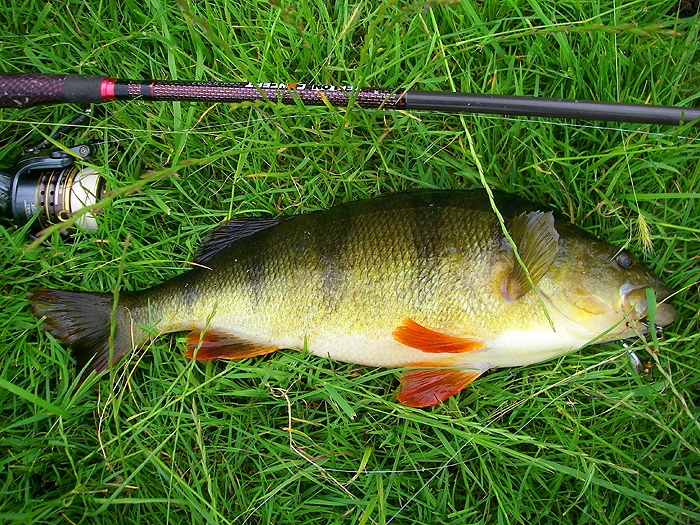
Returning to the question of how light affects perch fishing, studies in Sweden have explored the activity patterns of these fish under experimental conditions. Perch were caught in cage traps, transferred to tanks, and kept in natural daylight. The activity of the fish was recorded by using red light beams (invisible to the fish?) and photocells. This work was carried out to the North of the Arctic Circle. In the cold conditions the perch were only active from June to August, when water temperatures reached 8 to 12 degrees C. The thing to note is that: -
1. The longer the period the period of daylight, the more prolonged was the fish activity.
2. Near-surface swimming and feeding was much greater in the warmer months of the year.
3. In June the fish fed only in the middle of the day, but in July and August dawn and dusk were the peak times.
This (latter) double-peak of activity shown by perch, taking place as light intensity changes, is common in many other predatory fish. It seems to be an attempt by the crafty predators to take advantage of the semi-darkness to catch prey unawares while they are still visible. Or in other words, to see without being seen too easily. Sight feeders, like perch, are also able to catch confused prey which are moving from resting to feeding stations, or vice versa (i.e. on or off the “night shift”).
... and one on a luminous-bodied spinner after dark.
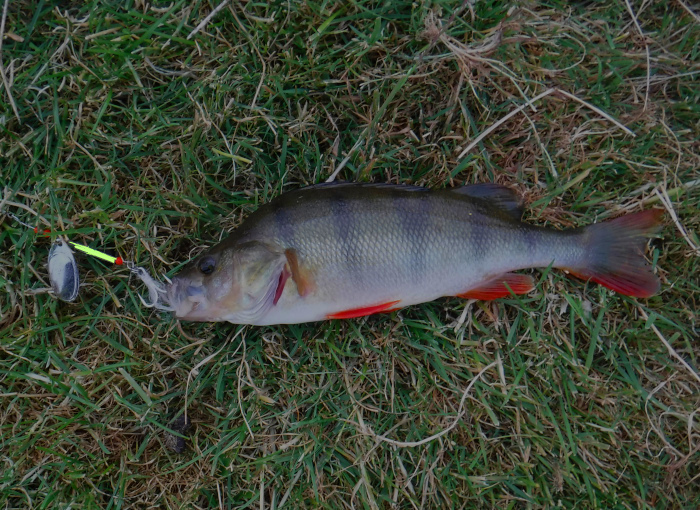
All these facts agree with the observations of Richard Walker and those of my own youth. To put it in a nutshell, perch are mainly active in the hours of daylight but, in the warmer summer months, they feed best at dawn and dusk. Added to this, they will feed at any time when there is an abundance of easy food or when coloured water and/or overcast skies produce the effect of an artificial dawn or dusk. This was clearly shown by the enthusiasm with which they took our Mepps-Minos when we fished on the River Wylye, near Salisbury (Part I).
Harry's biggest perch (3lb 7oz) was caught in August, from the River Avon at Stratford. Once again it took just as the light was failing and he was spinning with the only lure he possessed at that time, a small, gold-bladed Mepps. In this case his main problem was bringing the fish ashore as it was very lightly hooked and, due to inexperience, he was without a net. Like many anglers before and since, he was rescued by a nearby fellow fisherman.
Perch packs.
So, how do perch catch their food? Again, one of my early experiences illustrates the main tactics of the species. I was working my way around the reedy margin of the same quarry from which I caught my first big perch, casting out and retrieving a small, buoyant plug. Every gap and hole in the thick feathery beds of milfoil was searched with care but, after two hours of combing the water, there was still no sign of a fish. Suddenly, 20 metres from where I stood and well out into the Lake, the calm surface of the water was disturbed by dozens of tiny splashes as a shoal of fry sprayed in every direction. I watched the spot for a couple of minutes, during which time the ‘flash expansion’ of little fish was repeated three times. Slowly I retraced my steps along the shore until with a long cast (by my standards), the small plug was placed just beyond the disturbed area.
Another one on the plug.
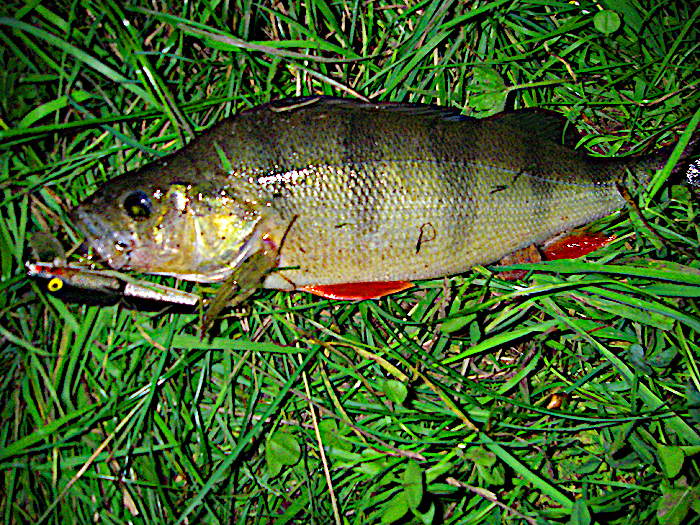
Almost before the line tightened there was a heart-stopping pull, and the perch of just under 2lb, firmly hooked on the tail treble, was played to the net. Before it became too dark to fish effectively three more good perch and a 7lb pike (which lunged from a weed bed on the last cast) were landed from the same area.
Once again, the sport came at dusk, the sort of action described involved three types of fish living in still-water; the prey (small roach) and two types of predator; The perch, a schooling chasing hunter and the pike, a lurking, ambushing form. The ways in which such fish interact have been studied by a Canadian researcher named Nursall.
Instead of roach or rudd the Canadian lake held huge schools of fish called ‘spot tail shiners’, but the predators, perch and pike, were the same. Like our rudd, the shiners are small, metallic-finish, surface- or near-surface feeders, with mirror-like scales. The shiners even behaved like rudd, swimming within a metre or so of the surface, with the smaller fish nearest the top and the largest ones deeper down. The fish, as a shoal, twist and turn in formation, often hesitating and suddenly changing direction. Any attack by a predator results in flash expansion of the shiners, with the little fish scattering in all directions from the point of attack. In escaping they often ‘spray’ from the surface of the water, giving away the position of the larger fish. The black spot in front of the shiners tail fin is supposed to be a signal to its shoal mates (like the white tails of rabbits) and enables them to react quickly to danger – I’m not sure that I believe this.
Spot tail shiner - rather like a minnow.
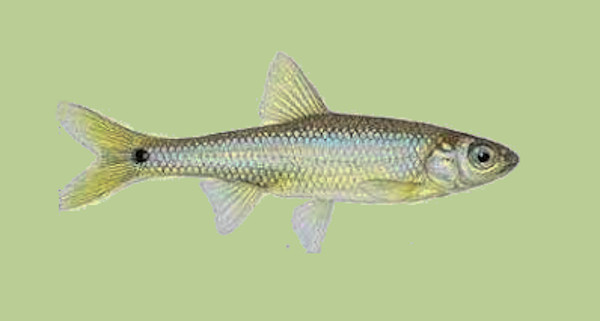
From a young age perch swim about in schools, and all the small fish in a school will often stream along in the same direction, rather like iron filings in a magnetic field. The big adult fish also stream in this way but, in this case, the movement is usually a form of ‘pack-hunting’. Pack-hunting gives the perch a better chance of making a capture than they would have on their own. When one perch tires of the chase another member of the pack takes over-rather like hunting dogs after a tiring antelope. A shiner, rushing from the attack of one perch may flee into the jaws of another.
Pike also feed on shiners, but they do not, as a rule, work in packs. They are solitary predators which take up a totally different approach; lurking in cover until the little fish swim close, before sculling round with their paddle-like fins to ‘line up their sights’ on the target. The tail, dorsal and ventral fins are bent round to one side, ‘setting the spring’ to prepare for launching the body. Ultimately the pike darts at its prey with high efficiency and this form of hunting has been called (by scientists) axial tracking and lunging.
From the angler’s point of view, one of the most interesting features is the way in which the feeding activity of one perch attracts the attention of others in the area. This attraction quickly leads to streaming and pack-hunting behaviour. Hence the use of big flasher-spoons and similar attractors could lead to greatly increased catches of perch and may be an excellent substitute for ground-baiting.
Shoal suicide.
Because of their social nature and the way in which members of a school must compete with their fellows for food, perch are liable to bite very freely. This well known, bold biting habit of ‘old stripy’ often results in big catches over short periods of time. Harry and I both recalled catching virtually a fish cast on every on several occasions. From small tree-lined ponds, from chalk-river backwaters, from lakes and from canals, we have landed fish after fish by spinning. Depending on the nature of the water the fish varied in size. From the clear and impoverished waters of lakes and ponds along the great Whin Sill in North-East England the average weight of the perch may be only a few ounces (with the pike not much bigger); while from the rich southern rivers every fish in a shoal may, at times, be well over a pound.
Perch tend to feed mostly on smallish fish, so little lures are usually effective, and the best of these will have the rapid flicker of small fry but can be fished in a controlled fashion near weeds and snags. Spinners fill the bill well, and we used to favour Mepps or better still the Mepps-Mino which is more controllable and on which many of our larger bags were taken. In truth I haven’t used one for many years now as they are less easily obtained, and I often use plugs these days.
A couple of my old Mepps Minos - not used for years but no doubt still effective.

Diagram of a Mepps Mino showing the set up of the hooks.
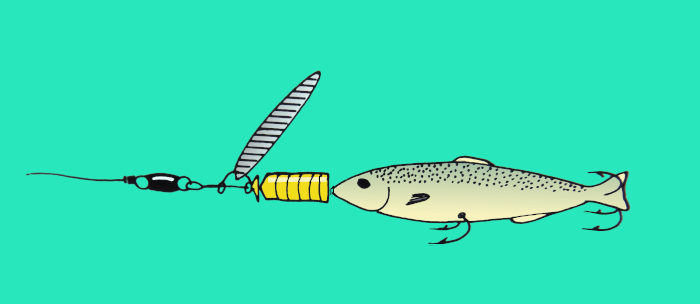
One final remembered experience may help to emphasise what I have said: -
Harry was working in Scotland and, as always, had taken his spinning rod. Having consulted mine-host at the local hostelry he discovered that it was possible to fish the club water on the nearby River for £2.00 a day (including salmon and trout). On the following morning he obtained his permit, and, after work, he rushed through his dinner and hurried to the river. There were lots of salmon in the stretch - he could see them - waiting below the fish-ladder of the local power station. Harry decided to make certain that he covered every fish, but he was certain that most of them would already have seen many lures and found them wanting. He began to fish and had only walked about 10 yards of bank when the rod jerked slightly, a bite? He struck and the fish was on, a one-pound perch. The action was repeated about 10 times in half-a-mile of river. Each perch weight between 8oz and 1lb and all the fish were caught on the spinner. Eventually the lure was exchanged for a large Toby spoon and the bites ceased, until darkness fell, when the Toby was taken by a 3.5lb seatrout.
Perch and plastics.
Perch are out and out, pack-hunting predators with the ability to ‘run down’ small fish. They will take plugs and spoons but, as already suggested, perhaps the most popular lure for them is a spinner of the Mepps type. Many anglers simply add a tassel to the hook to accommodate the ‘tail-nipping' activity of the chasing fish. I have caught a lot of these fish on plugs, including some decent sized specimens, but perhaps the most interesting tactic in recent years, has been the use of a jigged, lead-headed, soft plastic lure.
One of my first perch on a jigged, soft-plastic lure.
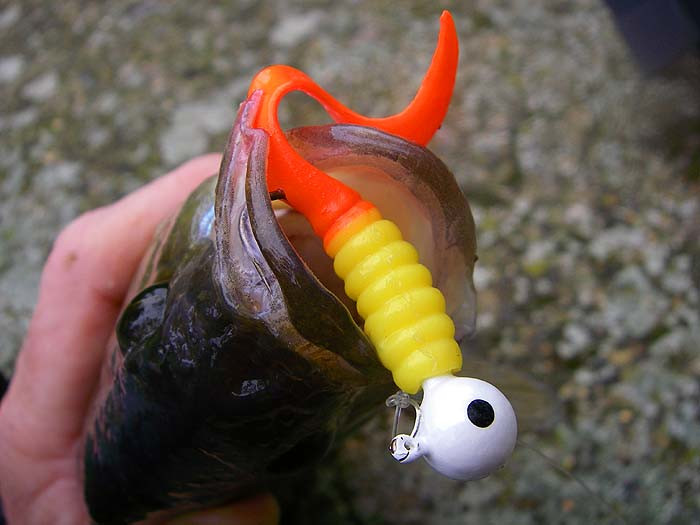
I find that I have a sort of 'angling inertia' when it comes to doing anything different. I shouldn't suffer from this because many of my most effective techniques, bass plugging, mullet spinning, maggot flies, circle hooks, weedless-softbaits, etc. etc., had to be tried for quite some time before they were trusted.
Anyway, in 2009 I decided to do something different to catch perch, just for a change. For years my pal Paul Froom had been catching good perch on soft-plastic 'grubs' and I'd been meaning to 'give them a go' but for some reason (angling inertia?) never got round to it. This time I was determined to give them a proper soaking. As it happened, that Christmas my grandson and ‘current number one fishing buddy’ Ben, had bought me a selection of lures which included several lead-heads and some plastic grubs. To make sure I didn't chicken out and tie on a plug, I only put the grubs in the box (and one little Rapala - just in case my confidence deserted me).
I went to a spot where I often catch perch, as there is little point testing something new in an untried place. I tied on a white, lead-head with a yellow body and red curly tail. It looked so garish I was already having doubts at this point. I flicked out the lure into the white water downstream of the weir and jiggled it back. Was this the way to do it - I'd no idea – nothing! Next cast went a bit further - nothing! My third chuck was right up against the sill of the weir. Cast, tighten, I'm in! A fish had taken the lure as it sank. Eureka!
The perch jiggled and sheared about, as they do, but it was no match for the bass tackle (still on from my last sea fishing trip). I was chuffed, my confidence was now sky high. I took a picture of the perch and popped it back. Next cast - wallop! Another perch, then another and another. By now I'm thinking this is easy, then I cast a bit further and let the jig sink. It went solid on an obstruction and I had to break it off. I rooted about in the box and found a slightly larger lead-head with a whiteish, silver-speckled body. On it went. First cast another bite and yet another decent perch. After several more fish, again I snagged up and lost the lure. How about a variation? I tied on an unweighted, white lure with a small uptrace bomb. Nothing! I swapped the plastic for my little Rapala. Still nothing! I looked at my watch, time to go home for my tea.
A couple of weeks later I was tempted to have another go with the jigged soft-baits. The tactic seemed to have the potential to select for the perch that I wanted to catch. I went to the same place at roughly the same times of day, so that I could eliminate the complication of where and when I was fishing. Even so, the river levels had changed a couple of feet and the water was a bit more coloured, but that's how it goes.
As I say, on my second trip it had rained, and the water was up a bit. I tied on a short wire trace with a smallish red and yellow curly tail and began to fish. The weir pool that had produced perch before seemed empty, at least I couldn't buy a bite. I moved on down casting and twitching the lure back across the bottom as I went. I did catch a few smallish perch and at one point, after I'd landed two or three from the same spot, a little pike took the lure. After a bit of a tussle it surfaced, shook its head and came unstuck.
My third trip found the river well down and pretty clear (it often has a bit of a 'tea stain'). This time, for no particular reason, I tried a white, fork-tailed lure. First cast to the weir sill and a fish was on - it was a nice one of over a pound. The second and third casts to the same area produced two more reasonable perch. Then I dropped one and the bites stopped. Presumably, the lost fish took its pals away with it. I went on downstream and landed one or two more smaller fish. Many of the usual ‘perchy’ places were now so shallow that I could see that there were no perch in them. I went back up to the weir pool and whanged the lure right across to the slack on the far side. Wallop! Clearly, I had hooked a pike and it was a decent size. The fish took line in a couple of runs but eventually I had it close enough to me to get a view. I reached for the camera and the fish came to the surface and (as they do) violently shook its head. The heavy, leaded lure flew out of its mouth.
This time on a white , fork-tailed jig.
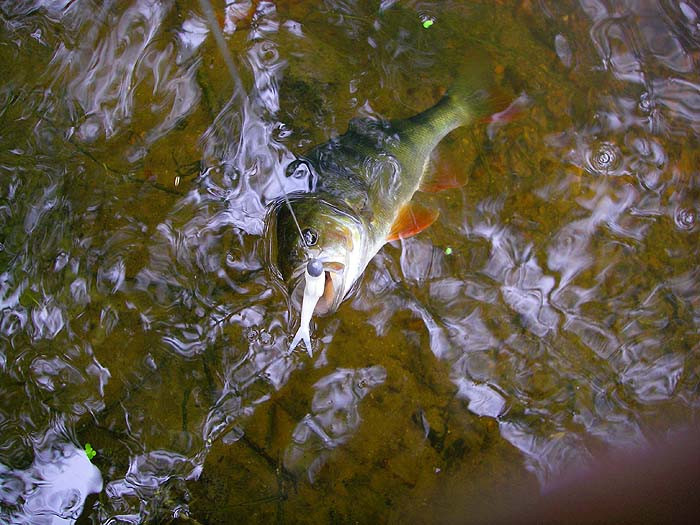
It was not until a couple-of-months later that I tried again. I thought that the heavy rain earlier in the week would have brought the river up and coloured the water, but it hadn't. If I'd known, I'd have gone fishing sooner. As it was, I decided to do a spot of spinning to see what I could catch on a lovely, sunny afternoon. Because of the low water level each swim was very different and although I don't usually change lures much during a session this time, I needed three changes to cover the options.
I started off in a deepish pool with a strong, turbulent inflow. A soft-plastic with a 7g lead-head seemed about right and sure enough first cast I was into a reasonable perch. This was a good opportunity for me to try out the time delay on the camera which failed to cope with a big bass a week or two earlier. Sure enough, I managed to get it to work but in the first picture I contrived to hide my face behind the fish (no bad thing you might say) and the second had too much contrast. Anyway, I thought it was a reasonable first attempt.
Several more casts and no more bites, so I switched to an 11cm, jointed Rapala. Needless to say, it didn't get down far enough in the deep water so, getting no bites I moved on downstream. A long cast into a pool below some gravelly shallows produced an excellent bite on the plug, from a decent pike sitting just behind the lip of the pool, but after a few seconds it came unstuck. I walked on further downstream to a wide gravelly shallow with overhanging trees on the far bank. The Rapala worked beautifully just above the bottom in the shallow water, and I had a few plucks and saw perch chasing after it. Clearly it was too big for them. I pitched the plug straight downstream along the near bank and just after it ‘splashed down’ there was a big swirl and a tug but again it wasn't hooked - 'big chub' I thought.
I changed the lure, this time for a small, slow-sinking plug about the size of a modest minnow. To be honest the hooks on this one were slightly too large, and occasionally the front one fouled the lip, or the two trebles locked together - this can be a real nuisance if you've just made a superb cast to the 'perfect spot'. Anyway, the change of lure sort-of-worked, and I hooked and landed several perch but there was no further sign of the chub. I returned to the place where I'd started and had a couple more perch from the deep water, by letting the lure sink for a while. I think that my mistake was not to use the slow sinker from the word go. If I had, I expect that the pike would have swallowed it, but I might well have caught a lot more perch and possibly even the elusive chub.
Spectacular seatrout.
Harry and I caught quite a few seatrout, over the years. Our main claim to fame with this species was recorded (anonymously, many years ago) in the Avon and Dorset (now Wessex) Water Authority salmon and seatrout-returns for the little River Piddle. The annual catch of seatrout for the river which we fished for a single season, one day a week, on the tidal stretch, showed a more than four-fold increase over the catch for the preceding year. The boost in results was due almost entirely to our efforts with small Mepps spinners, fished upstream, at dawn and/or dusk. In fact, at the time this was our only real foray into seatrout fishing and due largely to inexperience, we lost several of the bigger fish hooked while spinning (notably one monster hooked on a plug by me). Our catches on the Piddle were made despite the rather crude tackle which we were using at the time. The stretch of River was unbelievably snaggy and overgrown and, with the ever-present possibility of a large salmon, we tended towards the use of heavy (eighteen lb BS mono) lines and hefty rods.
My only previous experience of seatrout was gained while I was working for my Ph.D. at Budle Bay on the North East coast of England. Budle Bay is a large, rectangular inlet flanked by rolling sand dunes and paved with a wide expanse of fine sand. The grey waters of the North Sea retreat from the flats with each ebbing tide, to reveal twin streams of freshwater wandering across the Bay from the inland corners. In the deeper channel formed at the confluence of the two streams I spent many hours legering with rag worm for the fat flounders as they waited for the return of the tide to swim onto the flats. My tackle consisted of a small, solid-glass, spinning rod, a fixed spool reel and six-pound line, terminating in light leger tackle and a number six or eight, eyed hook.
The streams entering the North Sea across the sands of Budle Bay.
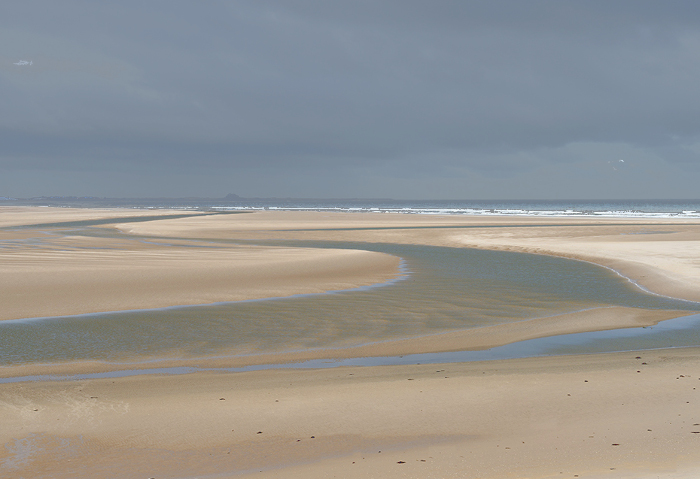
Most of my fishing was done at the crack of dawn before I began my day’s work. Often, as I waited at first light for a ‘flatty’ to take my bait, the quiet would be broken by the loud splash of a leaping fish. This was my first encounter with seatrout and sometimes I would have a clear view of the silver, shining, thick-set body of the fish, arched for an instant above the calm water, before it flopped back to send a succession of circling ripples over the surface. As I soon discovered, the seatrout were not interested in ragworm (at least not when or how I tried them) and, perhaps more surprisingly, I never contacted one on the legered sandeel which I sometimes used for flounders.
At that time, I was living with a shepherd, Bob Edmondson, and his family on a farm close to the village of Belford. I was able to fish the two little streams, the Ross Low and the Waren Burn, which ran into Budle Bay. Eels, flounders, and small brown trout were the usual catches but, after heavy rain, massive brownies would appear like magic in the thick, muddy water and could be extracted without difficulty on lobworm-baited tackle.
Where the big trout were at other times I never discovered, although I tried everything to catch them; bread, worms, flies, minnows, spoons - the lot! One evening after work I decided to spend yet another couple-of-hours after the elusive monster brown trout. The tackle was the same as that used for the flounders, but the business end consisted of a tiny link swivel and a size 1, silver Mepps. I caught a series of red-spotted, half-pound trout with almost monotonous regularity and, just as the light was failing, I was considering packing in. With the indecision common to most anglers in this situation, I changed my mind and decided to have a couple more casts into the slightly deeper, peaty-looking water under a small footbridge.
On the first cast I let the spinner sink for a couple of seconds and then began to retrieve smartly, to keep the blade working as the lure moved with the current. Almost at once there was a heavy pull on the rod top and, to my astonishment, the water exploded as a fish, much larger than any I had previously caught, launched itself from the water. Five-minutes of head shaking, racing, twisting, and thrashing later, I netted a 3.25lb sea trout, beautifully silver but with a rather large head and lean body – its poor condition was despite the fact that it was late June, long after the spawning time.
A poorly conditioned seatrout (but not as thin as the first one I caught from the Waren Burn).
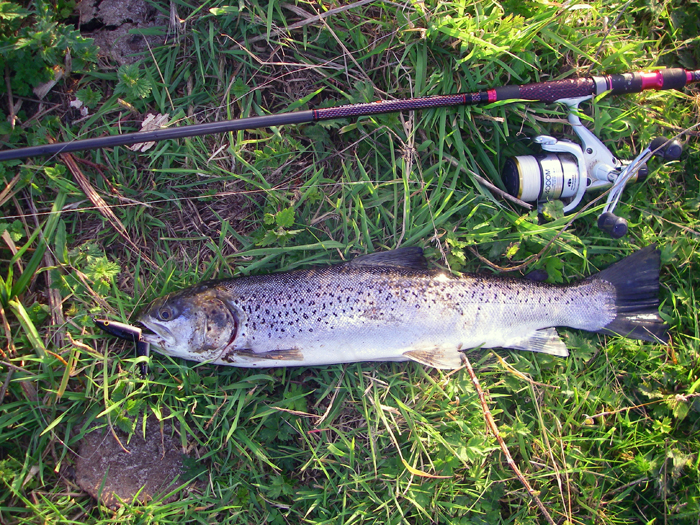
On reflection, I was lucky to land that fish, but since then I've caught many more and I still regard them as one of the most difficult fish to subdue and land, chiefly because of their incredible vitality. More recently, due to the decline in salmon numbers on my local river in Dorset (and apparently most other rivers), I have concentrated on lure-fishing for seatrout and have learned how to catch them much more consistently.
Seatrout in the sea
Most of my seatrout have been taken from rivers and streams but one or two were hooked in their real feeding habitat, the sea. While fishing from the steep rocky cliffs of the Donegal coast in North West Ireland the Toby spoon, intended for the bronzed and aggressive pollack, would occasionally be taken by a little, silver, lightning-bolt of a sea run trout.
My experience of seatrout in the sea is very limited, but I know that many game fishermen must, like the trout themselves, hanker after the salt tide flooding over the wrack beds of a distant sea loch. There can be few satisfactions greater than the pull of a wild, leaping fish, hooked on light tackle in the open sea.
Perhaps it may help to bring this dream a little nearer to reality if I recall the scientific observations of Dr Pemberton, in some sea lochs of North Argyll. Pemberton netted every two weeks through the year, to find out more about the movement of the fish after they came down to the sea as smolts. This downstream migration of the little silver fish was usually in mid-May, except in one very dry season when they were delayed by about a month. These ‘post-smolts’, as they were called, passed straight out through the loch. On several occasions over four-hundred of the small trout were taken in a single haul of the net.
The post-smolts grew very quickly and reached, what he called, the ‘whitling’ stage before returning to the lochs in August and September; by this time, they were twenty to twenty-five cm in length. About one fish in ten, at this season, was over twenty-eight cm from nose to tail. In October and November there were still plenty of whitling about in the lochs, but these were then augmented by a second, Autumn, run of smolts from the rivers. In the period from December to March whitling were most numerous at the river mouths and just outside the lochs.
In winter about one fish in seven was a skinny, drab-coloured, kelt but by February and March a quarter of the fish were large whitling in the twenty-five cm bracket, and these grew steadily bigger through the following spring.
The back end of a seatrout smolt with its red, adipose fin (salmon smolts and parr have a clear or yellowish adipose).
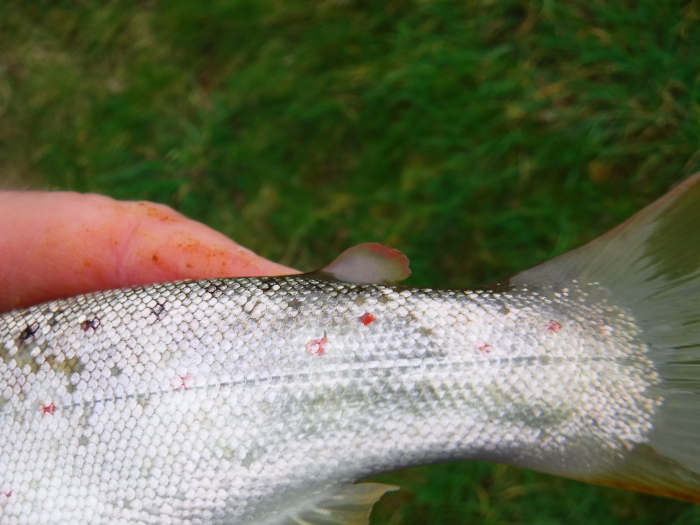
From the angling point-of-view, at least in Scotland, seatrout could hardly be more obliging. They almost invariably live and feed within two-hundred metres of the sea’s edge and often they are very much closer in; they are very rarely caught at any great distance from the rocks and beaches. Most of the fish hooked by anglers are landed in the period from March to May or in the late Summer and Autumn.
From March to November, my pals and I have spent thousands of rod hours spinning for bass on the Dorset coast, where several inflowing rivers are known to have runs of seatrout, yet only rarely have I seen anyone catch one of these fish. Why should this be? I have been unable to find any information on the movements of seatrout in the open sea in this area.
Pemberton’s sampling off the beaches of Scotland, throughout the day and night, produced peak catches in the nets at sunrise and sunset, particularly when this coincided with low tide. Even allowing for some fish avoiding the net during the daylight hours, these results are probably realistic because the fish were seen to move in and out of the river mouths with the tide.
In the open sea the catches of whitling were low in winter, and the mature trout averaging thirty-three to thirty-seven cm in length ran up the rivers to spawn from mid-October to mid-November. A recent study on the River Esk showed that many of the smaller fish (whitling) wandered to and fro between fresh and salt water several times in the same year.
When they were in the sea lochs the trout were, as I have said, feeding close inshore, often in very shallow water and there they took three main types of food:
1. Fish, which were essentially near-surface swimmers, such as sandeels, sprats and herrings.
2. Beach fleas and worms picked up from near the sea-bed (some of these animals may be members of the ‘night-tidal-plankton' and swim in the surf after dark – M.L.); and
3. Insects trapped in the surface film of the salt water.
Young fish and surface insects were eaten mostly in the warmer months of the year and bottom-living animals chiefly in the winter, but seatrout of more than 20cm in length fed mainly on small fish at all times.
So, there we have it - the picture of an almost perfect lure-angler’s fish. Hard-fighting, spectacular-leaping, living most of its life within easy casting distance of the shore in the shallow margins of the sea, and feeding on surface, mid-water, and bottom-living food. This must make the seatrout susceptible to a wide range of angling methods including bottom fishing, float fishing, fly fishing and especially spinning.
In recent years I have stopped fishing for salmon in my local rivers, because (almost everywhere) their numbers are now in serious decline, and I have largely switched to the pursuit of seatrout. The main differences in approach have been - (1) To fish shallower water (so no added lead) (2) To concentrate my efforts round about dusk and dawn (3) To use either small buoyant plugs or home-made, luminous-bodied spinners (I call them ‘Lumilures’). The results have been very satisfactory in terms of both numbers and size of fish caught (I rarely catch one small enough to be called a 'whitling'). I’ll give a few examples, taken from many trips over several years: -
It was August 2012. At last, the rivers seemed to be fishable. My previous session, a couple of weeks back, found my local stretch still bank high and tea coloured. An hour's spinning had not even produced a follow. Anyway, it was a sunny afternoon, and I had an hour to spare so I decided to give it another try. Apart from my short, knottable-wire, anti-pike trace the tackle was the same as I had used for bass the day before. My lure was a J9 Rapala, small enough to tempt trout and shallow-diving enough to fish over the weed and gravel bedded riffles.
My first cast was encouraging when a small trout had a nip at the lure. Next cast it followed again but this time was more wary. I flicked the lure towards some overhanging willows on the far bank and a seatrout of perhaps three pounds shot out and had a look before returning to its shelter. My spirits were rising. I cast down and across and slowly inched the lure back against the current. I was in! Soon a nice little browny of perhaps three-quarters-of-a-pound was on the bank.
After returning the fish, I plodded on upstream, casting up and across and retrieving just fast enough to keep the lure working. For fifteen minutes, nothing, then suddenly, in mid-river a fierce snatch and a big sea trout launched itself into the air. My heart was in my mouth and for a minute or two I wondered whether it was well enough hooked on the small trebles. I managed to prevent the fish going downstream, with the strong flow, past a big hawthorn bush (impassable on my bank) and began to feel that I was in control. Of course, I'd left my net behind, so the next problem was how to extract the fish without falling in. I slithered down the bank and with one hand on the tail wrist managed to stop the fish swimming off. I put my other hand under the trout's head (avoiding the needle-sharp hooks) and with a heave managed to get it on the soft, grassy margin. Now it was easy. Remove the hooks, take a picture, remove a few scales to be read, weigh the catch (12.5lb) and slip it back. Whewww!!!
A plump beauty, again on the jointed plug.
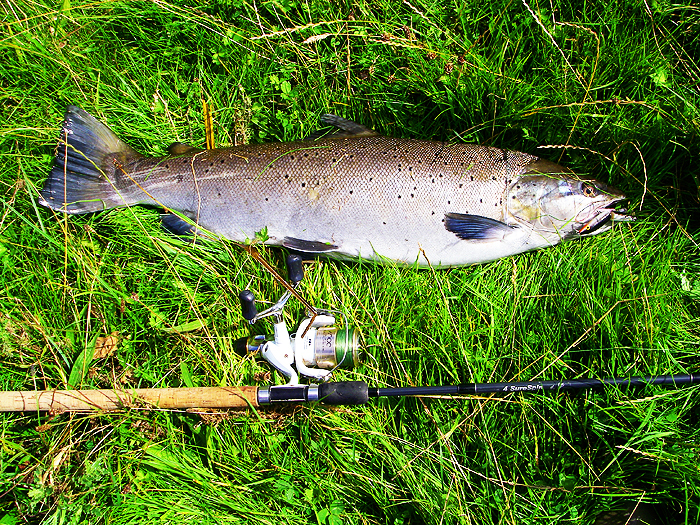
I thought about fishing on but that would have seemed greedy - so I went home. What a half-hour!
The next significant trip was a September one – approaching the end of the seatrout season. The last two days had been excellent evening tides for bass or mullet fishing. Unfortunately, I didn't make it on either day because of other commitments, but some of my pals gave it a go and caught a number of reasonable bass on lures, and mullet on maggot flies. The next evening, by the time I could get away to fish, it was already growing dark, so I thought I'd try the river, using my Lumilure, and see if I could manage to catch a consolation seatrout.
I started at the downstream end of the stretch and by casting up and across I worked my way up five or six paces at a time. To be honest it looked fairly dead, and I'd only had one or two tentative pluckers before it began to get pretty dark, and I was nearing the top of the section. I knew from experience that by this time of the evening the trout were likely to be in the tails of pools, and I was encouraged when there was a bow wave and a tug on the line as the spinner came downstream. The big advantage of the fine Nanofil line that I was using for this fishing is distance. The fish are pretty wary of anything (anyone) moving about on the bank, and time and again I've scared decent seatrout simply by approaching too near, so it pays to make long casts from a position well downstream if possible.
I'd been fishing for almost an hour and was just thinking that it might be time to 'give them best' when I approached the last big pool. More in hope than expectation I cast the spinner well up into the pool and started to wind, just fast enough to avoid snagging while keeping the blade ticking over. "The lure must be almost at the lip of the faster water now," I thought. There was a fierce pull on the line and a big fish exploded from the water and hurtled downstream towards where I stood. Every few seconds the seatrout hesitated in its rush to leap again. Ten or a dozen times it flew into the air thrashing and splashing wildly while I simply hung on to the rod with my heart in my mouth. Even though I couldn't see too much in the gloom it was clearly a nice seatrout and I didn't want to lose it before landing it, weighing it and having a good look. After five minutes of hectic action the fish (and me too) was beginning to tire a bit. I had it more or less under control and swimming close to the bank where I stood.
Now came the tricky bit - landing it - again without a net (can you see a pattern emerging? I can be forgetful). Usually, I can slide into a shallow spot and lift them out or beach them but here the bank was two feet above relatively deep, fast flowing water. I lay down on my belly in the nettles and handled the line in towards me until I could reach down to the nylon trace. At this point it was a toss-up whether I extracted the fish or slid head-first into the drink. I was lucky. I just managed to lift the head of the fish enough, so that I could get a grip on it with my right hand (my left hand's just an ornament) and drag it onto the grass beside me. Phew!!! What a relief. I took a couple of piccies, unhooked it, popped it into the bag and weighed it at just under nine pounds. My best that year and almost making up for missing out on the bass/mullet fishing.
Another nice fish caught in the dark on a luminous spinner.

A close up of the luminous-bodied lure.
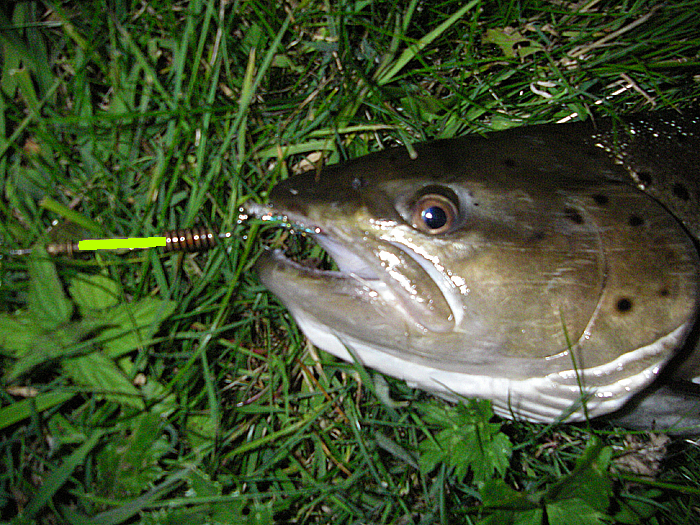
A selfie of a nice fish caught by spinning at dusk.
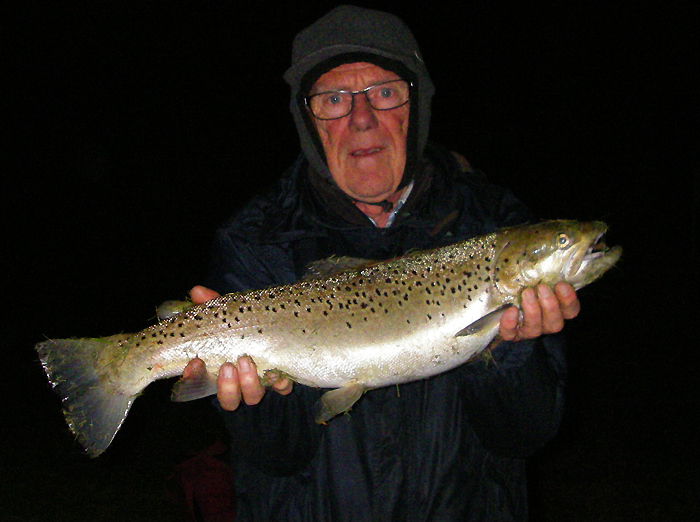
A few days later and still no sea fishing for me. On the one occasion I managed to get to the coast it was a blank. After that, when I was free to go, it blew a hoolie. Still, that's fishing - not the first time it's happened and surely not the last. Anyway, my pal Richard and I had arranged a trip, and with the saltwater venue being ‘blown off’ we decided to go to the river. Last time we’d tried Richard managed a seatrout so again he targeted these fish with a small, minnow-style plug. I had a change of tactics with a big, wobbled deadbait in search of pike - my logic being that at least we would be fishing different bits of water (glides and runs for Richard and slacks for me). As it turned out my pal had forgotten to bring his rainwear and the forecast wasn't good, but when we started to fish it was still dry, if a bit overcast. We decided to give it an hour or so on the stretch nearest to the parked car as the rain clouds were gathering and the sky looked ominous.
To be honest it was pretty poor fishing. We saw the odd fish jump and not long before we packed in, I had a take from a modest pike which dropped the bait twice. I decided that it couldn't cope with my large bait and after another quarter-of-an-hour we gave it best and went home disappointed. The following evening my wife said she had to do some work on the computer and by the time it reached 7 pm I was getting a bit twitchy. As usual, there was nothing watchable on the telly (there rarely is); so, I grabbed the little Teklon spinning rod, still fitted with the Mitchell reel and Nanofil line, attached a short, wire, anti-pike trace and clipped on the size 4 luminous spinner which produced the big seatrout.
I only intended fishing for less than an hour as dusk fell, but after the fiasco trying to land the last decent trout, I decided to cart along my big carp net, which has a handle long enough to reach the water, even where the banks are fairly high. For fifteen minutes I worked my way upstream, and nothing happened. I reached the first significant bend in the river and on the far side there was a small slack. The howling downstream wind made casting difficult, but I managed to flick the lure up and across into the slow flow and began to retrieve at once before it sank into the weed. A sharp tug, tug turned into a full-blown yank on the line and there was a huge swirl and splash as I hooked a decent fish. The taker rushed about the river in a series of short sharp runs, but it never broke the surface again, so I was beginning to suspect that it wasn't a seatrout but a pike. To my surprise it turned out to be neither but a salmon of about nine pounds which I was able to net, unhook and return quickly to the water, only hesitating to take picture of it in the net. Excellent!
An accidental, stale, salmon caught while spinning for seatrout.
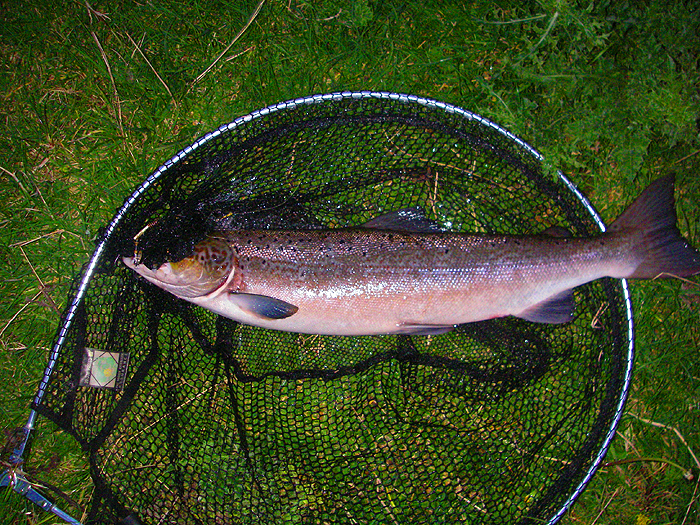
I plodded on upstream to the next pool above a wide, fast flowing, shallow stretch. The first cast upstream produced nothing, and the strong wind was proving tricky, so I walked upstream and cast straight across the tail of the pool. About half-way back the lure was grabbed by a seatrout of a pound-and-a-bit which didn't put up much of a struggle on my spinning gear. I took its picture before returning it to the water. Two fish in five minutes - even better. Time for a few more casts so I moved on up towards the next pool and standing well downstream I pitched the lure up into the smooth water above the tail. Almost at once it was seized and a good fish flung itself into the air like a Polaris missile. By now it was pretty dark, and I couldn't really see what I'd hooked, but from the fierce runs and succession of jumps I guessed that it was a big seatrout. It seemed ages before I was able to coax my fish into the net where it proved to be a big, spotty, male fish of over seven pounds. Once more it was unhooked, photographed and returned. Three fish in half-an-hour's fishing - bonanza! I packed in and walked back to the car.
Late in the season seatrout develop spawning colours which make them look like brownies.
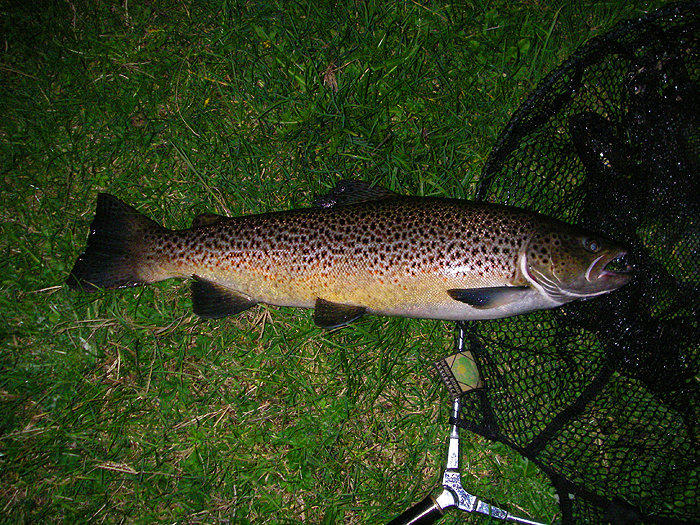
Now it was June of the following year. I'd already had a few smallish seatrout but generally it had been a slow start to the season. Anyway, I'm a persistent, old, so-and-so, and every few days I gave it another try. This year there seemed to be a good deal more streamer weed in the river than usual and this made fishing across or down and across with a plug (one of my favoured tactics for big seatrout) quite difficult, so I opted to spin a Mepps. These lures work well if they are cast upstream and retrieved just fast enough to spin with the flow. In this way they slide easily between the fronds of water buttercup, so most places are fishable.
As my time was limited, I decided to try a stretch close to the place where the car was parked. Starting at the downstream end I was going to work my way up having a couple of casts every five or six paces. If I can the first cast goes up and across so that it will land under the far bank, the next one goes up the middle and the third one is straight up the near bank. Of course, it's not always possible to squeeze three casts in at every spot and sometimes I have to walk quite a long way before I find another fishable place, but that's the general approach. I started at the tail of a large pool and to cover the water I needed four casts, each one to a point further upstream. The fourth was almost at my distance limit and the lure plopped in right under the far bank where the water was several feet deep. I waited for a couple of seconds as the lure sank and then began to wind. I could feel the Mepps 'gripping' the water, so I knew that it was working well. About half-way back to where I stood there was a sharp tug, and I was in. Then all hell broke loose.
I saw the flash of silver as a decent fish turned then the rod bowed towards it. The seatrout immediately set off on a fast upstream run. The clutch buzzed and line streamed off as it powered away. The fish paused and then set off again. Several times the trout took a lot of line but eventually it began to tire, and I worked it back down into the tail of the pool where I stood. Downstream of me was a fast, deep run and I didn't want the fish to get into the strong flow if I could help it. I took a few paces downstream to try and persuade it to go back up again, but it jumped and crashed back in before turning and rushing down into the current. The only thing to do was follow it, so I did. Now it really was beginning to tire so after another minute or two I was able to steer the seatrout onto a shallow, gravelly bank, slide it ashore and after taking a couple of pictures and weighing it, return it to the river. Six-and-a-half pounds of fat, sleek, silver seatrout what a way to start.
Another fine seatrout on the luminous spinner.
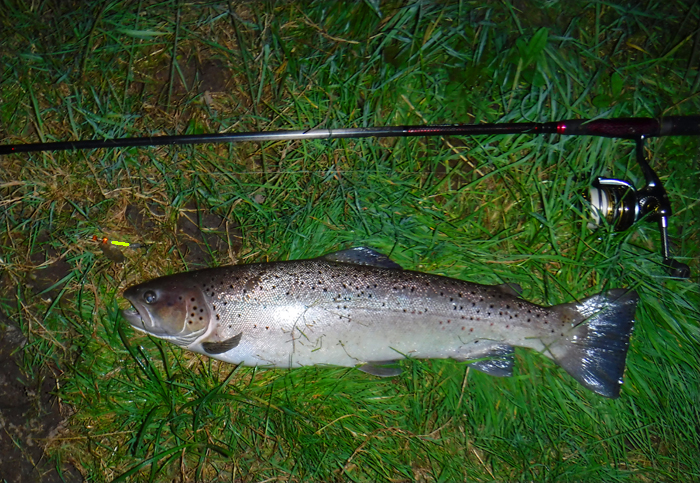
I pressed on upstream, but the next stretch seemed devoid of fish. Then I had a pluck and saw a big red fish - probably another seatrout - turn away. It showed no further interest. The next cast was into shallow water and produced a tiny browny. Not long afterwards I cast up my own bank and landed a fine, very spotty seatrout of two-and-a-half pounds. After that I decided it was time to go home for my supper. All in all, not a bad session.
- - - and on that successful note the book ends – but with a postscript.
Neither Harry nor I ever advocated breaking rules and regulations, but it is worth noting that, in many cases, the rules are designed to make catching fish more difficult. This may on occasion, be necessary to protect the stock from unscrupulous or greedy anglers. Nowadays in the age of commercially run, put-and-take fisheries, the owners will often make a great many rules, chiefly to obtain the best financial gain from their investment. We both thought that it would be a pity if such rules of convenience became Water Authority (now Environment Agency) bylaws, thus restricting all anglers and stifling initiative and new ideas.
Angling is (still) faced with enough problems from pollution, indiscriminate netting, or commercial overfishing (including removal of immature fish in the case of species such as bass) and the anti-angling lobby, without having artificial divisions within our sport. Finally, there is, of course, no rigid division between the different types of lure and usually, when you are fishing, the compromise solution to accommodate species and conditions, will be the best starting point. No matter how realistic the shape and action of your lure may be, it will not catch anything unless you can reach the fish with it, and having done so, it will need to cope with the depths, currents, snags, etc. For example, if the wind blows the balsa plug back in your face or if your expensive spoon plunges to the bottom and stays there it will be useless. In short it is always handy to carry a (small) range of lure weights, sizes, actions and forms which allow you to fish easily at various depths. This doesn’t mean that you need to lug about a suitcase full of lures in every shape, size and colour of the rainbow.
In my bag are a couple of plastic boxes of lures intended to cope with almost everything. I’m lazy, and I find it easier to simply take ‘everything’ with me. Home or abroad. Pike, perch, seatrout, salmon, bass, pollack, mackerel, mullet, bonefish, barracuda, jacks, snook and tarpon are all catered for. As a rule, it is handy to have two of each main type (in case you lose one) and it is rare that I feel stumped for a suitable lure. I have just decided to add one more chapter which was not in the original book. In this, I shall list my Go-To lures for some of the main species that I have fished for. This will not be the usual author’s list of ‘every lure ever made and sold’ or even ‘all the good and effective lures you can buy-and-try for a particular species.’ I shall simply mention the few types which I have found to be most useful and successful for catching the fish I am after. In other words, these will be the lures which I am confident will provide me with the maximum sport, with decent specimens under a range of conditions.
– PLEASE TELL YOUR TWITTER, FACEBOOK, EMAIL FRIENDS ABOUT THESE BOOKS.
ANGLING ON THE EDGE
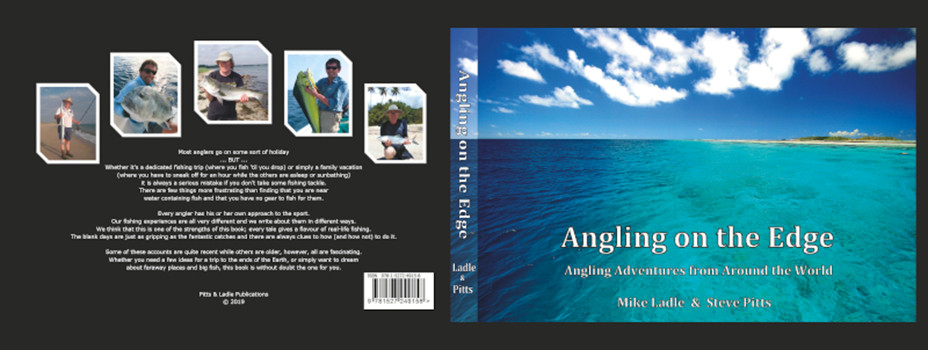
Copies can now be ordered (printed on demand) from Steve Pitts at £34.00, inc. Royal Mail Insured UK Mainland Postage.
To order a book send an E-MAIL to - stevejpitts@gmail.com
FISHING FOR GHOSTS
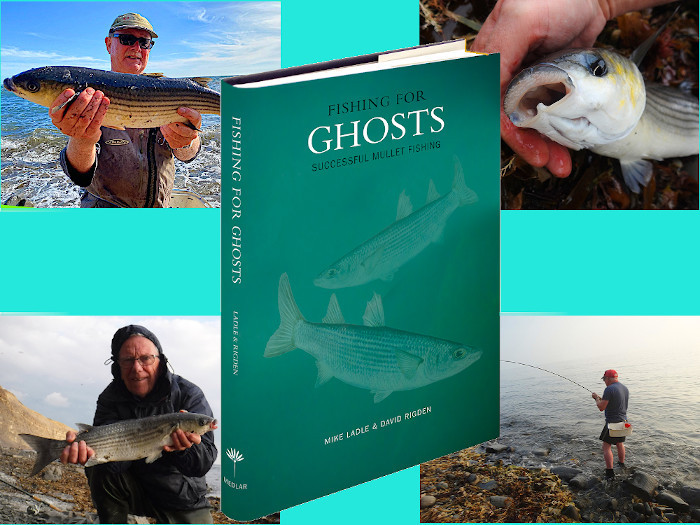
Written with David Rigden. Copies from
THE SECOND WAVE
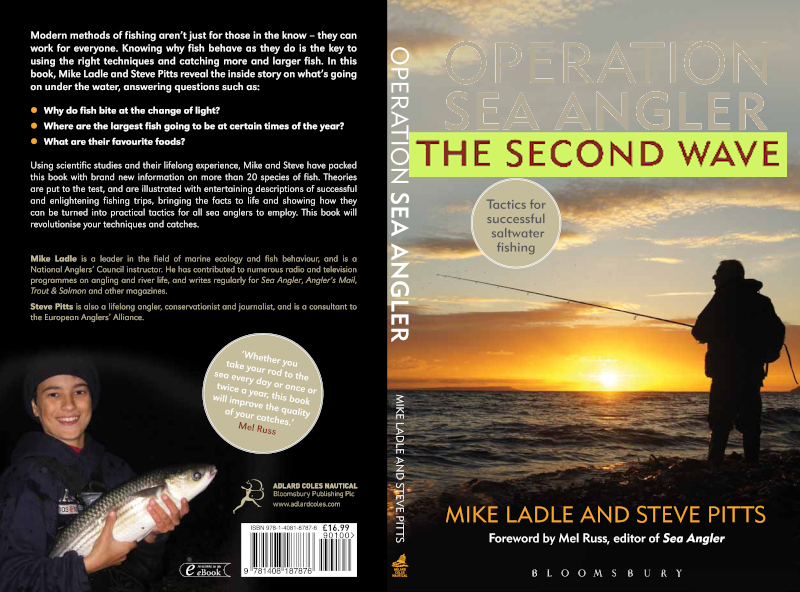
Written with Steve Pitts this is a SEQUEL TO THE BESTSELLER "Operation Sea Angler" IT'S AVAILABLE ON PAPER FROM -
If you have any comments or questions about fish, methods, tactics or 'what have you!' get in touch with me by sending an E-MAIL to - docladle@hotmail.com